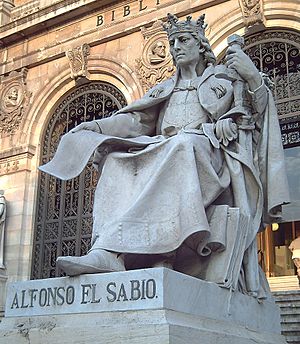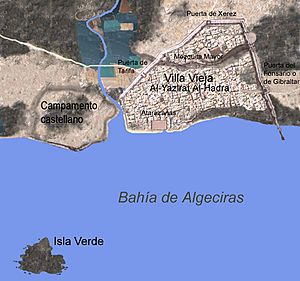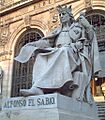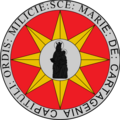Siege of Algeciras (1278–1279) facts for kids
Quick facts for kids Battle of Algeciras |
|||||||
|---|---|---|---|---|---|---|---|
| Part of the Reconquista | |||||||
 Alfonso X of Castile "the Wise", King of Castile |
|||||||
|
|||||||
| Belligerents | |||||||
| Commanders and leaders | |||||||
The siege of Algeciras was a long military attack on the city of Algeciras in Spain. It was ordered by King Alfonso X of Castile, also known as "the Wise." His goal was to remove the Marinid (Benimerin) forces from Algeciras.
Algeciras was very important because it was the main port for troops coming from Africa to the Iberian Peninsula. Before the siege, the Castilian navy, which was blocking the port, was destroyed by Muslim ships in the Naval Battle of Algeciras. This made the siege much harder for the Castilians.
Contents
Why the Siege Happened
Since the mid-1200s, the Marinid Dynasty grew powerful in Morocco. Their leader was Abu Yusuf Yaqub ibn Abd Al-Haqq. They helped the Muslims in Al-Andalus (Muslim Spain) fight against the Christian kingdoms during the Reconquista.
In 1275, a large Moroccan army landed in Algeciras. They marched towards important Castilian cities like Seville and Córdoba. The Castilian prince, Ferdinand de la Cerda, tried to stop them.
Another Castilian leader, Nuño González de Lara, fought the Moroccans and died, but he forced them to retreat. Later, Prince Sancho, who would become Sancho IV of Castile, took charge. He strengthened Castilian positions and prepared to fight the Marinids.
In 1276, the Muslims and Castilians signed a two-year truce. However, the Marinids stayed in Algeciras and Tarifa, keeping many troops there. Meanwhile, King Alfonso X of Castile had problems deciding who would be the next king. He wanted his son Sancho to rule, but some nobles wanted the children of his dead son, Fernando, to take the throne.
The Attack on Algeciras
King Alfonso X decided to attack Algeciras because he knew that as long as the city was controlled by the Moroccans, it was a threat. Algeciras, called Al-Jazira Al-Khadra by Muslims, was the first city founded by Muslim conquerors in Spain in 711. It had strong walls and defenses.
In March 1278, King Alfonso X sent his sons, Prince Pedro de Castilla y Aragón and Prince Sancho, to gather troops in Seville. Their army then marched towards Algeciras. The first part of the army was led by Alfonso Fernández de Castilla, the king's illegitimate son.
On August 5, 1278, the Castilian army arrived at Algeciras. About 30,000 soldiers surrounded the city. A fleet of 24 ships and 80 galleys was also in the Bay of Gibraltar. Their job was to stop supplies from reaching the city from nearby Gibraltar. However, this fleet was completely destroyed in the Naval Battle of Algeciras.
The Castilian fleet was led by Pedro Martínez de Fe. Many members of the Order of Santa María de España, a military-religious group focused on naval warfare, were part of this fleet. On land, the Castilian soldiers dug trenches and used siege weapons to attack the city walls.
The first few months of the siege were tough. Soldiers from Algeciras would attack the Christian camp. Inside the city, large crossbows called ballistas fired at the besiegers. In February 1279, King Alfonso X himself arrived to lead the siege. But after many months, the siege didn't move forward. Both sides suffered heavy losses.
By April 1279, the Castilian camp started running out of food and supplies. This was partly because their fleet had been destroyed. Also, not enough supplies were sent from Seville. It was later found that some of the money meant for the siege was being used by Prince Pedro for other reasons.
The summer was very hot, and the water supplies became bad. This caused a terrible disease, like the plague, to spread through the Christian camp. Soldiers on the ships were especially sick because they had no proper food or supplies. By July 1279, many sailors left their ships to join the ground troops, hoping for better care. This left the Castilian ships almost empty.
The Muslim Fleet Arrives
During the siege, Algeciras used messenger pigeons to communicate with Gibraltar. They told the Moroccan king about the bad conditions in the Castilian camp. Hearing this, the Moroccan king gathered 14 galleys (ships) in Tangier.
On July 19, the Muslim galleys, led by the king's son, Abu Yaqub Yusuf an-Nasr, were ready. By nightfall, they reached the Bay of Gibraltar. On July 20, the Muslim fleet attacked the nearly empty Castilian ships anchored at Isla Verde. The Castilian fleet was quickly defeated, and their boats were captured. All prisoners were killed, except for the officers who were taken hostage. This was the second time in two years that the entire Castilian fleet was lost.
The Castilian army on land was surprised by how quickly their navy was destroyed. They couldn't stop the Muslim ships from sailing into the city. Muslim soldiers then quickly came out of the city gates and attacked the Christian besiegers. Prince Pedro, who was in charge of the siege, fled the battle. He left his captains to be captured and lost all their siege weapons to the enemy.
What Happened Next
After this defeat, King Alfonso X was forced to sign a new truce (peace agreement) with the Marinids later in 1279. The King of Morocco then built a new town, Villa Nueva de Algeciras, where the Castilian siege works had been. This was to make sure that future attackers couldn't use those same good positions again.
Images for kids
-
Alfonso X of Castile "the Wise", King of Castile
See also
 In Spanish: Sitio de Algeciras (1278-1279) para niños
In Spanish: Sitio de Algeciras (1278-1279) para niños







